Fighting a Flood of Disinformation in the Western Balkans
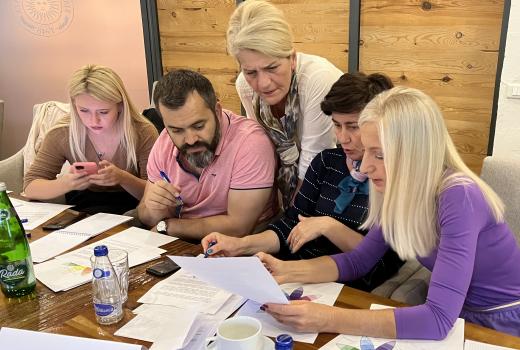
Fighting a Flood of Disinformation in the Western Balkans
10/03/2023
To reduce the impact of disinformation, civil society organizations across the region work to strengthen media literacy among old and young.
No matter where in the Western Balkans you live, you are exposed to large volumes of disinformation that may shape your attitudes towards health, politics or public safety.
Like elsewhere, during the COVID 19 pandemic, citizens had to deal with disinformation every day. In one instance, information based on a photo of dead bodies that was falsely claimed to have been taken in an Italian hospital caused Dijana Tiganj, a 27 year-old high school teacher from Montenegro, to feel anxious. It later turned out the photo was not taken in the hospital, nor during the COVID 19 pandemic. Nevertheless, at first, Dijana believed the information was true.
“In my case, that information caused panic which was limiting during COVID 19. I immediately reduced all my social contacts, I was manic in spraying with alcohol, and especially worried about the oldest housemates. I didn’t go out unless absolutely necessary”, says Dijana.
A few years ago in neighboring Serbia, a 27 year-old youth worker, Gordana Adamov, had doubts about the origin of a photo that linked bird deaths to the 5G network in Serbia. It was the first time Gordana used reverse image search to find the original photo source.
“I think that was the first time I felt the need to find the original source and warn people who were sharing fake news in groups that it was disinformation.”
Fake and inaccurate reports are particularly dangerous if they further fuel hatred and discord, especially in ethnically divided communities. In Kosovo, citizens have recently been exposed to intense disinformation campaigns around the rising tensions in the north of the country.
When last November some Kosovo media outlets reported about a car with Serbian license plates being set on fire, they stated that the arrested suspect was a former citizen of Kosovo. The information turned out to be incorrect as Kosovo Police confirmed that the owner of the car and the suspect were neighbors. They were both Kosovo citizens of Albanian ethnic background and a personal disagreement was the likely motive. That the motive had nothing to do with ethnicity Leonita Morina (24) from Pristina, a project assistant in a consultancy, found out by getting information from different sources.
“I realized it was disinformation because some other media and professionals warned us that disinformation and fake news related to the situation in the north of Kosovo were spreading quickly.”
CSOs response - fighting disinformation with education, research, art and games
Without promotion of media and digital literacy, the battle against disinformation is incomplete, believe the specialists of Hibrid.info, a fact-checking platform in Kosovo. With the aim to raise the level of critical and analytical thinking of the citizens, they created Checkos, an online learning tool based on a number of types of digital quizzes.
The proposition is straightforward – Checkos users are instructed to read articles containing problematic content and then take a quiz made of questions about the relevance of facts, the reliability of sources and the structure of articles. After completing the questionnaire, the system automatically generates the quiz results and indicates the level of the users’ media literacy skills.
The app is currently out of action due to a lack of financial resources, but at Hibrid.info they hope to bring it back to life soon in a more advanced version. Until that happens, they continue to publish fact-checking and media literacy related articles as well as research reports on disinformation.
“If the audience is educated in accessing the information they come across in the digital space, the effect of misinformative content will be much smaller”, specialists at Hibrid.info point out.
Another organization from Kosovo found an interesting way, using illustration as a form of artistic expression, to address the problem of disinformation and other challenges modern journalism is facing, such as lack of independence. Within Resilience, a regional project implemented in six Western Balkans countries and Turkey, Kosovo 2.0 created a series of ironic cartoon illustrations questioning citizens’ resilience to many troublesome aspects of today’s media.
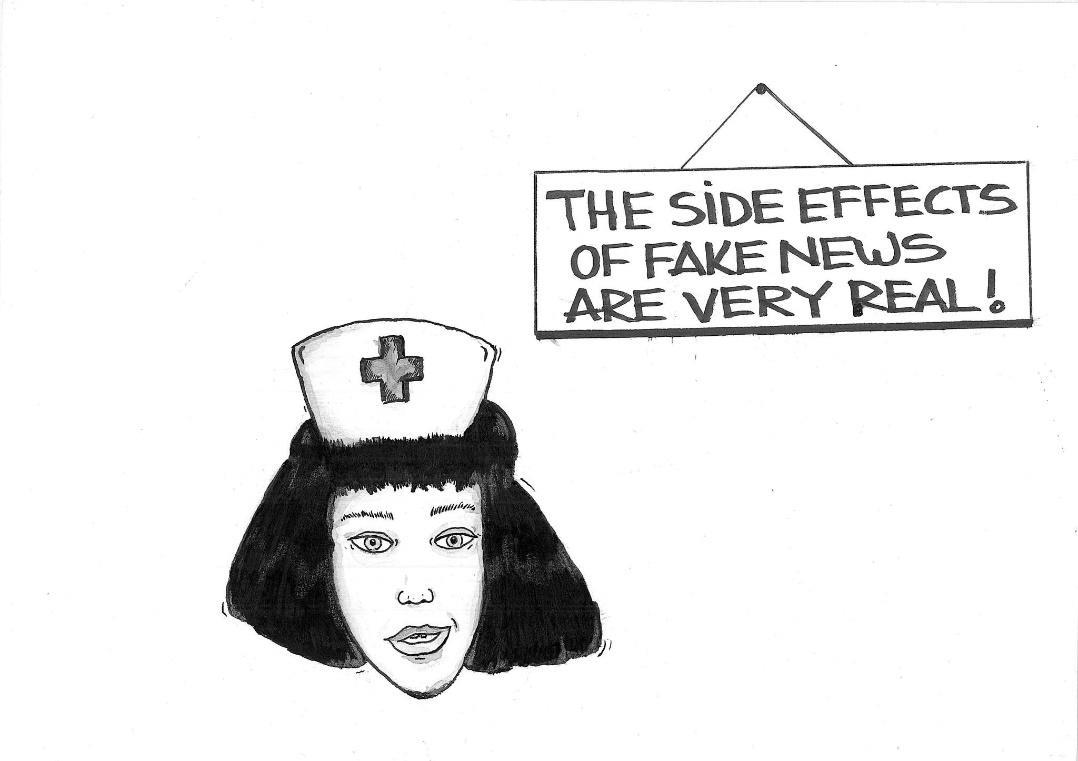
Photo: Illustration created within the Resilience project, collaboration of Kosovo 2.0 and Arif Muharremi
In Albania, one of the most influential civil society organizations focusing on media development, Albanian Media Institute (AMI), has joined forces with young people to strengthen community resistance to problematic media content. At the beginning of last year AMI invited individuals aged 18-30 to participate in a competition for the best design of a poster on media and information literacy. AMI received 22 applications competing for one of three cash prizes. The winning posters were promoted online and will soon be distributed to universities across Albania.
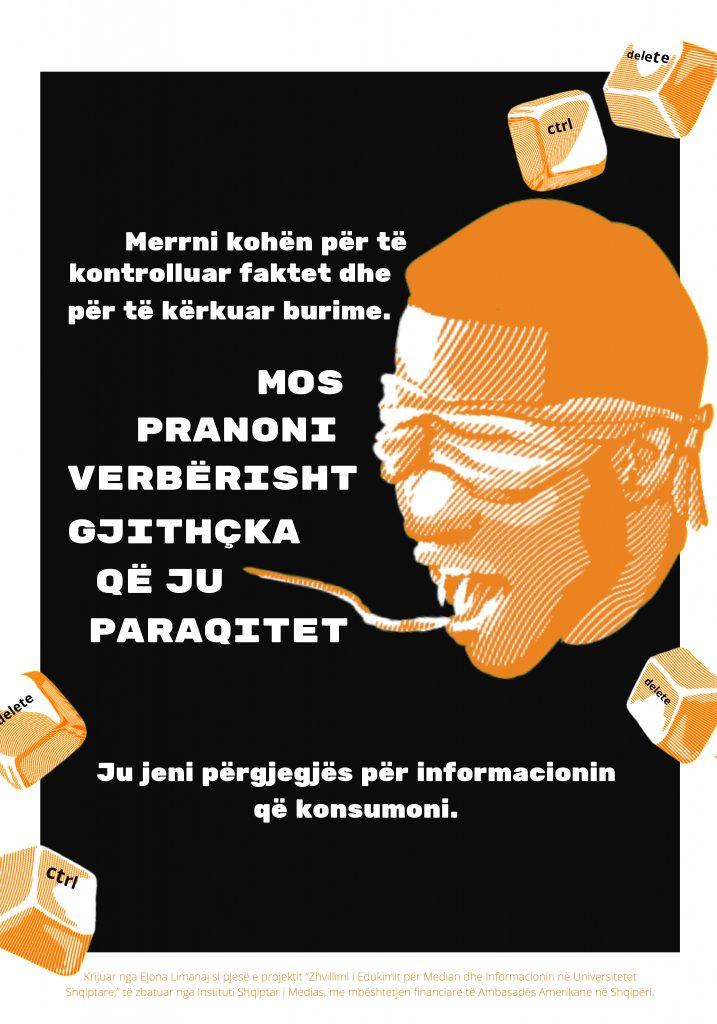
Photo: One of the winning posters saying: Take your time to check the facts and look for sources of information. DO NOT ACCEPT EVERYTHING THEY OFFER YOU AT FACE VAULE. You are responsible for the information you consume.
AMI has also launched Students and Media Literacy Blog that publishes pieces on various media topics written by Albanian students. Some of the blogposts analyzed problematic media coverage and importance of media literacy among youth, while others reflected rather personal perspectives on students’ experiences with different media trends. The blog covers topics on media narratives related to COVID 19, mistrust in science, practical tips for identifying disinformation and other.
In Serbia, Novi Sad School of Journalism (NSSJ) decided to fight disinformation by creating an outdoor game for citizens of Novi Sad. A 10x10 meter installation in the form of a labyrinth was set up at a popular city location to attract citizens to enter it and test their knowledge about disinformation.
The outer walls of the installation, illustrated with the works of the artist Oli Popins, humorously depicted communication traps such as apophenia, pseudoscience or deepfake, while visitors tested their knowledge inside the labyrinth. The game was based on six forks – six different tasks, where a correct answer leads to the next task and a wrong one to a dead end. While it was installed, approximately 50 people a day entered the labyrinth, including children who saw it as a source of entertainment.
“Most visitors had positive comments about the innovative approach and the design that targeted different techniques of media manipulation through humorous comics. However, some people were damaging the installation so we often had to repair parts of it”, says Marina Grnja from NSSJ.
The idea behind the installation was to use an innovative and interactive approach to bring different topics of media manipulation and disinformation closer to diverse public and send the message that “only true and correct information lead to an exit from the labyrinth”, Grnja points out.
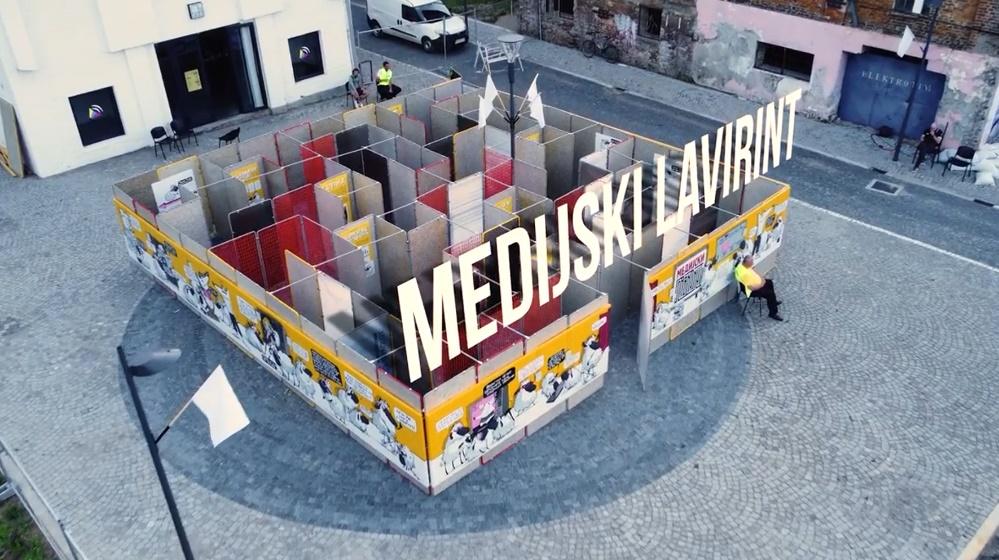
Photo: Media Labyrinth
After devoting a lot of work in the field of media literacy to children and young people, in Montenegrin Media Institute (MMI) they realized they should focus more on adults who neither learned about this subject in schools, nor have developed habit of non-formal, lifelong learning. For the past two years, using a curriculum developed by IREX, MMI has been educating citizens to become media literacy trainers and organize workshops for the wider community. Trainers go through a four-day training and then hold a one-day workshop based on interaction and practical exercises.
“Citizens were so interested in this program, it exceeded all our expectations”, says Dina Bajramspahić from MMI. Many important, but very often neglected topics in Montenegrin public discourse, are covered by the workshop: media standards, fake news and disinformation, apps and algorithms, social networks and their challenges.
40 trainers have held workshops attended by more than 600 citizens, which is a large number for this type of activity in Montenegro, explains Bajramspahić. She believes that this number will be even higher because the project has a potential for self-sustainability.
“At this point we already have a group of people who are able to implement the program outside the scope of the project. That’s something we encourage and they do it.”
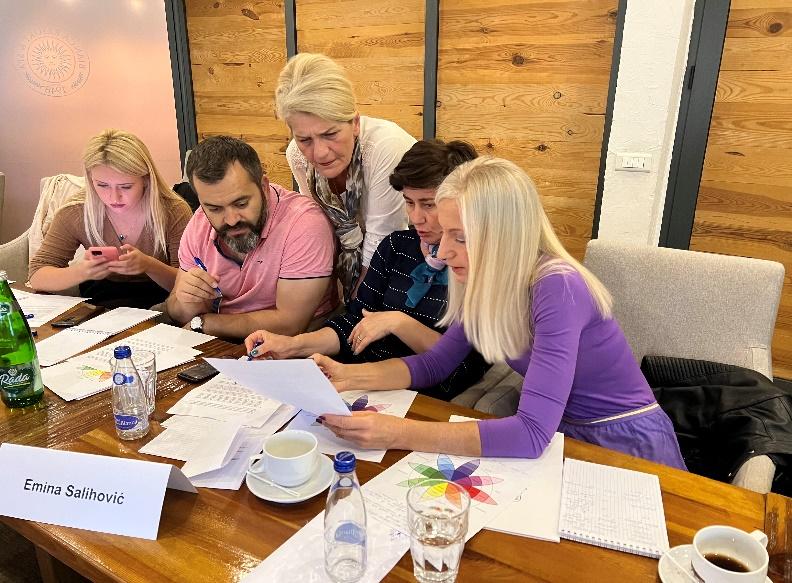
Photo: Participants during a workshop organized by MMI
In Bosnia and Herzegovina, Mediacentar Sarajevo has been monitoring how different types of harmful narratives, including disinformation, about women politicians are being spread in the media and on social networks during the election campaign 2022. The monitoring focused on the ways gender and gender roles are used in election campaigns and how harmful narratives targeting women candidates can affect election process.
The danger of such narratives lies not only in mere disinformation and manipulation of voters, and diverting attention from serious political issues, but also in the normalization of verbal violence against women in public space, Mediacentar specialists explain.
“This has unfathomable, long-term consequences for the position of women in society, it is a step back in the fight against gender-based violence”, says Maida Muminović from Mediacentar Sarajevo.
A comprehensive analytical report on harmful narratives based on several months of research will soon be published. In the meantime, Mediacentar Sarajevo presents the main research findings through infographics on its social networks.
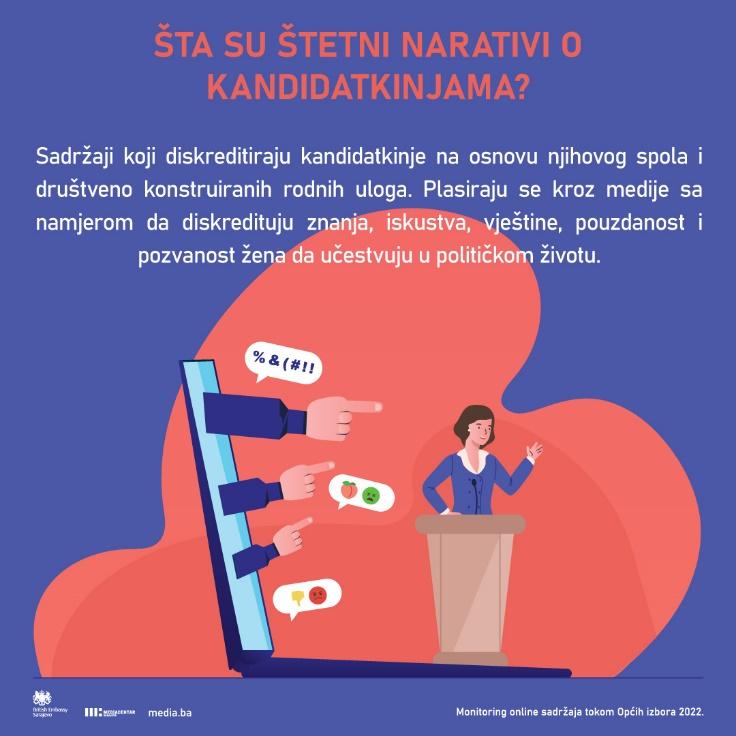
Photo: WHAT ARE HARMFUL NARRATIVES ABOUT WOMEN CANDIDATES?
Content that discredits women candidates based on their gender and socially constructed gender roles. It is being disseminated through the media with the intention of discrediting the knowledge, experience, skills, dependability and right of women to get involved in politics.
In North Macedonia, Macedonian Institute for Media (MIM) joined numerous organizations across Europe that set up the exhibition The Glass Room: Misinformation Edition. Together with the Delegation of the European Union, MIM organized the exhibition, which was initially developed and launched by Tactical Tech, a Berlin-based international NGO. Within this setting, there is also Data Detox Kit, which outlines specific steps on how to use technology in a smart and responsible way.
“In addition to the exhibition, we are organizing several interactive workshops for adults and young people that include themes related to the Data Detox Kit”, says Ivona Vasilova from MIM.
The Glass Room explores different types of misinformation and teaches visitors how to recognize problematic content. It is designed as a self-learning installation, consisting of a series of posters, interactive apps and animations, and can be hosted in public or private spaces and visited online. The Misinformation Edition has been translated to 27 different languages, as stated on the official The Glass Room website.
Since its launch in 2020, the Glass Room: Misinformation Edition has been visited by more than 30.000 guests across Europe and has reached hundreds of thousands more online. In North Macedonia, hundreds visited the exhibition at Europe House Skopje. The next stops for the show are the North Macedonian towns Kriva Palanka and Strumica.

Photo: The Glass Room exhibition in Skopje, MIM

Funded by the European Union
The regional program ‘RESILIENCE: Civil society action to reaffirm media freedom and counter disinformation and hateful propaganda in Western Balkans and Turkey’ is implemented with the financial support of the European Union by partner organizations SEENPM, Albanian Media Institute, Mediacentar Sarajevo, Kosovo 2.0, Montenegrin Media Institute, Macedonian Institute for Media, Novi Sad School of Journalism, Peace Institute and Bianet.
This article was produced with the financial support of the European Union. Its contents are the sole responsibility of SEENPM and do not necessarily reflect the views of the European Union.




